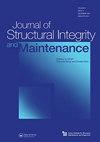Detailed vulnerability assessment and seismic upgradation of non-engineered masonry building
IF 3.1
Q2 ENGINEERING, CIVIL
Journal of Structural Integrity and Maintenance
Pub Date : 2021-04-03
DOI:10.1080/24705314.2021.1875176
引用次数: 4
Abstract
ABSTRACT Structural safety of code deficient non-engineered buildings relies on adequate strengthening measures, which demands detailed structural assessment and strengthening using the appropriate technique. Structural appraisal of non-engineered buildings with poor construction practices is a key issue, which requires immediate attention. This paper deals with seismic evaluation and rehabilitation of a seismically deficient unreinforced masonry (URM) building. A Detailed Vulnerability Assessment (DVA) was carried out, which included visual inspection; on-site and laboratory tests on building elements, linear static and dynamic analysis to identify structurally deficient elements through evaluation of stress parameters. The existing building was found to be in distressed condition with regards to material and structural requirements as speculated from DVA, further to which adequate strengthening techniques for seismic upgradation of the building were proposed. The main strengthening measures included galvanized iron welded wire mesh (GI WWM) and shotcrete for walls and columns, along with micro-piles-cum-raft for foundation. The building was re-analyzed after strengthening, which showed improved structural parameters complying with the codal limits. It is expected that the proposed seismic evaluation and rehabilitation methodology will be helpful to practising engineers for improving the seismic resilience of URM buildings.非工程砌体建筑详细易损性评估及抗震改造
缺乏规范的非工程建筑的结构安全依赖于适当的加固措施,这需要详细的结构评估和使用适当的技术进行加固。对施工质量差的非工程建筑进行结构鉴定是一个关键问题,需要立即予以重视。本文研究了某地震缺陷无筋砌体(URM)建筑的抗震评价与修复。进行了详细的脆弱性评估(DVA),包括目视检查;建筑构件的现场和实验室测试,线性静力和动力分析,通过评估应力参数来识别结构缺陷。根据DVA的推测,现有的建筑在材料和结构要求方面处于困境,进一步提出了适当的抗震升级加固技术。主要加固措施为墙、柱采用镀锌铁丝网和喷射混凝土加固,基础采用微桩加筏加固。加固后对建筑进行了重新分析,结果表明改进后的结构参数符合规范限制。期望所提出的地震评估和修复方法将有助于执业工程师提高URM建筑的抗震能力。
本文章由计算机程序翻译,如有差异,请以英文原文为准。
求助全文
约1分钟内获得全文
求助全文
来源期刊

Journal of Structural Integrity and Maintenance
ENGINEERING, CIVIL-
CiteScore
3.90
自引率
9.50%
发文量
24
 求助内容:
求助内容: 应助结果提醒方式:
应助结果提醒方式:


